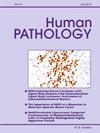Intracranial low-grade tumors with ALK rearrangement: diverse tumor types with shared molecular alterations
IF 2.6
2区 医学
Q2 PATHOLOGY
引用次数: 0
Abstract
Although anaplastic lymphoma kinase (ALK) gene fusions are increasingly recognized in newly classified pediatric high-grade gliomas, intracranial low-grade tumors harboring ALK rearrangements remain under characterized in the literature. Herein, we present five cases of low-grade intracranial tumors with ALK rearrangements that were diagnosed at a single institution over a continuous 24-month period. Comprehensive clinicopathological evaluation integrating morphological analysis, immunohistochemical profiling, and molecular characterization of fusion partners was performed. Microscopic examination was performed to assess histologic features. A panel of antibodies were used to evaluate protein expression including ALK, desmin, GFAP, Olig2, S100, NeuN, EMA, and CD34. DNA and RNA sequencing was performed, and potential fusion transcripts were analyzed using seed count and structural chromosomal aberrations. All five tumors harbored structural aberrations involving the ALK locus 2p23, and no additional pathogenic mutations, amplifications, deletions, or fusions were identified in all the cases. Among them, two tumors were inflammatory myofibroblastic tumors (IMT) with SQSTM1::ALK, and NPM1::ALK fusion, respectively. One was a tanycytic supratentorial ependymoma (ST-EPN) with HNRNPA1::ALK fusion, and another was ganglioglioma (GG) with PPP1CB::ALK fusion. Interestingly, one case presented as a low-grade myxoid mesenchymal neoplasm with ATIC::ALK rearrangement that did not fit any existing tumor category. All patients underwent complete tumor resection, and were alive with no signs of recurrence during a follow-up period ranging from 1 to 18 months. In summary, ALK fusions may be shared features of a group of low-grade intracranial tumors including IMT, tanycytic ST-EPN, GG, and ALK-rearranged low-grade myxoid mesenchyma neoplasm. Future studies using larger cohorts are warranted to further characterize their clinical and pathological features.
颅内低级别肿瘤伴ALK重排:不同类型肿瘤共享分子改变。
虽然间变性淋巴瘤激酶(ALK)基因融合越来越多地在新分类的儿童高级别胶质瘤中得到认可,但在文献中,颅内低级别肿瘤中存在ALK重排的特征仍然不足。在此,我们提出5例低级别颅内肿瘤与ALK重排,诊断在一个单一的机构在连续24个月期间。综合形态学分析、免疫组织化学分析和融合伙伴分子特征进行综合临床病理评估。显微镜检查评估组织学特征。一组抗体用于评估蛋白表达,包括ALK、desmin、GFAP、Olig2、S100、NeuN、EMA和CD34。进行DNA和RNA测序,并使用种子计数和染色体结构畸变分析潜在的融合转录本。所有5例肿瘤均存在涉及ALK位点2p23的结构畸变,并且在所有病例中均未发现其他致病性突变、扩增、缺失或融合。其中2例为炎性肌成纤维细胞瘤(IMT),分别与SQSTM1::ALK、NPM1::ALK融合。其中一例为单细胞性幕上室管膜瘤(ST-EPN)伴HNRNPA1::ALK融合,另一例为神经节神经胶质瘤(GG)伴PPP1CB::ALK融合。有趣的是,1例表现为ATIC::ALK重排的低级别黏液样间充质肿瘤,不符合任何现有的肿瘤类别。所有患者均接受肿瘤完全切除,随访1 - 18个月,均存活,无复发迹象。综上所述,ALK融合可能是一组低级别颅内肿瘤的共同特征,包括IMT、增胞性ST-EPN、GG和ALK重排的低级别黏液样间质肿瘤。未来的研究需要使用更大的队列来进一步表征其临床和病理特征。
本文章由计算机程序翻译,如有差异,请以英文原文为准。
求助全文
约1分钟内获得全文
求助全文
来源期刊

Human pathology
医学-病理学
CiteScore
5.30
自引率
6.10%
发文量
206
审稿时长
21 days
期刊介绍:
Human Pathology is designed to bring information of clinicopathologic significance to human disease to the laboratory and clinical physician. It presents information drawn from morphologic and clinical laboratory studies with direct relevance to the understanding of human diseases. Papers published concern morphologic and clinicopathologic observations, reviews of diseases, analyses of problems in pathology, significant collections of case material and advances in concepts or techniques of value in the analysis and diagnosis of disease. Theoretical and experimental pathology and molecular biology pertinent to human disease are included. This critical journal is well illustrated with exceptional reproductions of photomicrographs and microscopic anatomy.
 求助内容:
求助内容: 应助结果提醒方式:
应助结果提醒方式:


